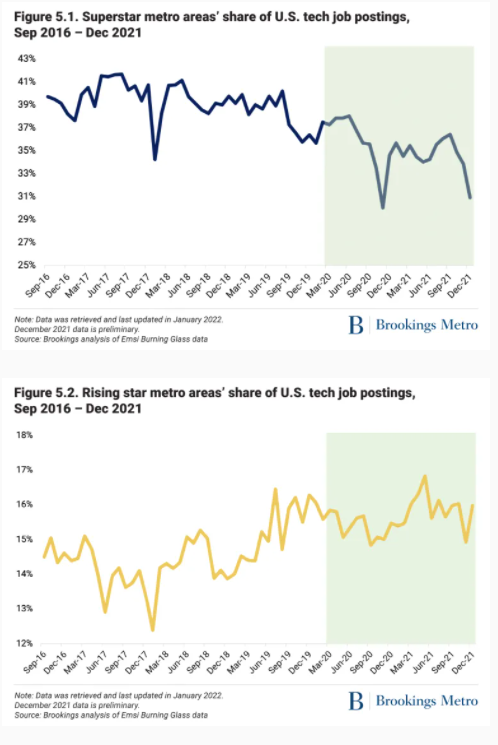Even before working from home became a standard, tech was starting to decentralize, as smaller hubs popped up alongside giants like Silicon Valley and New York City.
Then the COVID-19 pandemic hit, and the tech workforce went almost entirely remote. People liked it — the flexibility, the increased work-life balance, the lack of a daily commute. And now, two years later, remote work has become a highly desirable perk of tech work. It’s impacting everything from how prospective employees pick workplaces to the health of downtown centers.
Not least of all, it has been a factor on the pandemic-era tech migration patterns, as seen in a new report from the Brookings Institution.
In 2021, tech workers migrated to Sun Belt cities in droves. Miami saw a massive 30% net increase in software and IT workers; Orlando, San Diego and San Antonio also saw rapid growth.
It seems that many tech workers decided that, if they were going to spend the vast majority of their time at home, including work time, might as well make it warm and sunny.
Still, it’s not as cut and dry as that. There was an exodus from New York City in 2020. Then, it bounced back: The city may have lost tech workers to sunny Florida, but even more tech workers eventually returned, even with its high cost of living and relatively cold winters.
“It’s really interesting,” said Mark Muro, an author of the report and a senior fellow and policy director at Brookings Metro. “People expected there was going to be this huge exodus from all big cities. I actually was really surprised New York actually gained, and none of the big tech hubs lost a catastrophic amount of workers. But there were enough workers moving around to give some momentum to a lot of new and different and smaller places.”
Read the reportPlaces that are generally not thought of as tech hubs have drawn in tech workers — like Madison, Wisconsin; Provo, Utah; Tulsa, Oklahoma; and Lincoln, Nebraska. (The report notes that Technical.ly market Pittsburgh is also growing, while Philadelphia’s share of the nation’s tech startups rose significantly by 1.7%; those markets have been noted elsewhere as being an “emerging” startup hub and one that already has a globally recognized startup ecosystem, respectively.)
With all of this migration, it may seem like remote work means the possibilities are endless, but there are, in fact, limits. The growing tech hubs are cities, and most if not all have made intentional moves to draw tech workers, from improving broadband infrastructure to offering perks for relocating. And don’t forget the pointed calls for tech workers from Miami’s mayor.
“[The growing tech hubs] don’t have huge tech communities, so if anybody shows up, it’s visible,” Muro said. “But they also have really tried. Lincoln has had a pretty good startup community around their university. Tulsa is one of those places that is trying to recruit and attract workers. They have something called Tulsa Remote, which has relocation subsidies” — including a $10,000 grant when a remote worker purchases a home in Tulsa.
But if you dream of working remotely not from Miami or Tulsa, but from a cabin in the woods or in a rural area, you may have to wait a while. Rural high-speed internet is a part of the Federal Infrastructure Law, but until those upgrades are made, working remotely in an area without it remains a challenge.

“If you’re a community out in the country that wants to attract these tech workers, you probably need to do some things like look at whether you’re creating a welcoming, diverse environment for tech workers, a good ecosystem, and really good infrastructure in the form of broadband,” Muro said. “If they’re not really thinking through what it takes to support tech people, then they’re probably not going to move the dial.”
At the end of the day, the tech sector is changing. Muro’s takeaway:
“Multiple things are happening at once,” the researcher said. “The big tech superstars aren’t going anywhere. But more, newer and different places seem to attract new tech growth. Tech, as an industry, didn’t have a terrible crisis during the pandemic. In fact, it accelerated in some ways, because so much business was rolling onto the internet, whether it was ecommerce or meal delivery or the development of new conferencing tools, and that created openings for more communities.”







